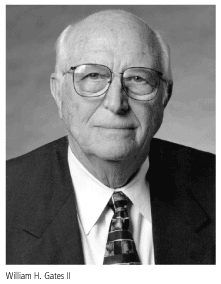Interview
Wealth for health a Gates perspective
The Bill & Melinda Gates Foundation is one of the largest philanthropic organizations in the world. Since its creation in 1999, it has donated over US$ 1.6 billion to health and learning. One of the people in the foundations driving seat is William H. Gates II, its co-chair and chief executive officer. After nearly 50 years of practising law, Bill Senior spends much of his retirement overseeing the foundation. He gives Barry Whyte some insights into how the foundation chooses the recipients of its largesse.

Barry Whyte Last year the foundation gave away nearly US$ 1 billion, of which about US$ 550 million to public health initiatives. What are its priority health targets?
Gates Vaccine-preventable diseases, reproductive health and child health, and conditions associated with poverty, such as dracunculiasis, or guinea-worm disease, and lymphatic filariasis, two largely neglected diseases. We look mostly for preventive solutions, such as vaccines. Developing just one new vaccine while difficult and costly can have a gigantic impact. If I were a betting man, Id put most of my money on what would have the greatest impact over time, and I believe that impact will come from the vaccine grants.
BW How do you choose who gets the grants?
Gates We get experts together from around the world and from different organizations. They convene meetings, talk to others in the field and then seek out proposals. We are also lucky to have outstanding experts on our staff, such as Dr Gordon Perkin, director of our global health programme, and Dr William Foege, our senior adviser, who played a pivotal role in eradicating smallpox and has been a director of the US Centers for Disease Control and Prevention. These experts, along with the rest of the global health staff, actively seek out proposals, which are vetted and sent to Ms Patty Stonesifer, the other co-chair at the foundation, and myself.
BW What do you look for in a successful application?
Gates We are pleased when organizations work together to secure a grant from the foundation. The Global Alliance for Vaccines and Immunization (GAVI) and the Global Fund for Childrens Vaccines are good examples. GAVI and the global fund were formed to save the lives of some three million children every year by making sure all children have access to life-saving vaccines.
BW What are the roles of Bill and Melinda Gates in the selection process?
Gates Bill and Melinda are very involved in the funding process: all grant proposals over US$ 1 million go to them. They really keep the global health staff on their toes. The staff just finished a 30-page email of answers to some of the questions Bill had. Both Bill and Melinda were in India recently and were deeply moved at seeing how health workers are devoting their lives to the fight against HIV/AIDS, poliomyelitis, and other global health problems.
BW How do you monitor performance once a grant has been issued?
Gates Our staff is trying to find appropriate evaluation tools. Since we look for centres of excellence during the grant-making process, we hope for good results. Thats not to say we wont fall flat on our faces thats part of taking risks. However, if one of the groups weve funded finds a vaccine for HIV/AIDS or malaria, the payoff will be large and may save millions even billions of lives.
BW Do you believe there are specific sectors in society that could do more for global health?
Gates I think we can all do better governments, businesses, and private citizens. The amounts spent by industrialized countries on global health problems cant begin to meet the needs. Yet, together, we have the compassion and the resources to bring to an end the disparity in health between populations.
BW Do you think pharmaceutical companies could be more committed to developing drugs for diseases prevalent in developing countries?
Gates There is a handful of programmes that are working Merck and its ivermectin for river blindness (onchocerciasis); Smith Kline Beecham, now Glaxo-SmithKline, and its albendazole for lymphatic filariasis, for example. But it shouldnt be a handful it can and should be hundreds of successful programmes. Other options exist. For example, the International AIDS Vaccine Initiative (IAVI), which relies on social venture capital, aims to accelerate the development of an HIV/AIDS vaccine that will be accessible and tailored to developing countries.
BW Which projects funded by the foundation are you particularly pleased about?
Gates In April, vaccines arrived in Mozambique the first of several dozen that had little or no access to childrens vaccines before. This was one of our very first big grants, US$ 750 million, that went to the Global Fund for Childrens Vaccines. Children in developing countries have often had to wait 10 to 15 years before they could have access to the same vaccines that are protecting children in the United States. Thats changing, and it couldnt have happened without a concerted effort by governments and organizations to make access to vaccines a priority. Together we could help save the lives of at least three million children every year. Now thats pretty awesome! 
